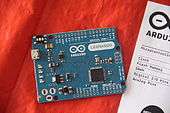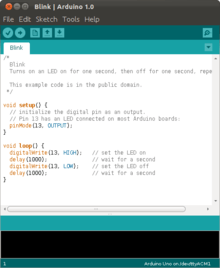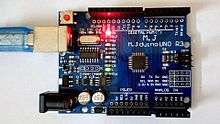Arduino
|
| |
|
"Arduino Uno" SMD Revision 3 | |
| Type | Single-board microcontroller |
|---|---|
| Website |
www |
Arduino is an open-source computer hardware and software company, project and user community that designs and manufactures microcontroller-based kits for building digital devices and interactive objects that can sense and control objects in the physical world.[1]
The project is based on microcontroller board designs, manufactured by several vendors, using various microcontrollers. These systems provide sets of digital and analog I/O pins that can be interfaced to various expansion boards ("shields") and other circuits. The boards feature serial communications interfaces, including USB on some models, for loading programs from personal computers. For programming the microcontrollers, the Arduino project provides an integrated development environment (IDE) based on the Processing project, which includes support for the C and C++ programming languages.
The first Arduino was introduced in 2005, aiming to provide an inexpensive and easy way for novices and professionals to create devices that interact with their environment using sensors and actuators. Common examples of such devices intended for beginner hobbyists include simple robots, thermostats, and motion detectors.
Arduino boards are available commercially in preassembled form, or as do-it-yourself kits. The hardware design specifications are openly available, allowing the Arduino boards to be manufactured by anyone. Adafruit Industries estimated in mid-2011 that over 300,000 official Arduinos had been commercially produced,[2] and in 2013 that 700,000 official boards were in users' hands.[3]
History
Arduino started in 2005 as a project for students at the Interaction Design Institute Ivrea in Ivrea, Italy. At that time program students used a "BASIC Stamp" at a cost of $100, considered expensive for students. Massimo Banzi, one of the founders, taught at Ivrea.[4] The name "Arduino" comes from a bar in Ivrea, where some of the founders of the project used to meet. The bar, in turn, has been named after Arduin of Ivrea, who was the margrave of Ivrea and King of Italy from 1002 to 1014.[5]
Colombian student Hernando Barragán created the Wiring development platform which served as the basis for Arduino. Following the completion of the Wiring platform, its lighter, less expensive versions[6] were created and made available to the open-source community; associated researchers, including David Cuartielles, promoted the idea. The Arduino's initial core team consisted of Massimo Banzi, David Cuartielles, Tom Igoe, Gianluca Martino, and David Mellis.[4]
Hardware

An Arduino board historically consists of an Atmel 8-, 16- or 32-bit AVR microcontroller (although since 2015 other makers' microcontrollers have been used) with complementary components that facilitate programming and incorporation into other circuits. An important aspect of the Arduino is its standard connectors, which lets users connect the CPU board to a variety of interchangeable add-on modules known as shields. Some shields communicate with the Arduino board directly over various pins, but many shields are individually addressable via an I²C serial bus—so many shields can be stacked and used in parallel. Prior to 2015 Official Arduinos had used the Atmel megaAVR series of chips, specifically the ATmega8, ATmega168, ATmega328, ATmega1280, and ATmega2560 and in 2015 units by other manufacturers were added. A handful of other processors have also been used by Arduino compatible devices. Most boards include a 5 V linear regulator and a 16 MHz crystal oscillator (or ceramic resonator in some variants), although some designs such as the LilyPad run at 8 MHz and dispense with the onboard voltage regulator due to specific form-factor restrictions. An Arduino's microcontroller is also pre-programmed with a boot loader that simplifies uploading of programs to the on-chip flash memory, compared with other devices that typically need an external programmer. This makes using an Arduino more straightforward by allowing the use of an ordinary computer as the programmer. Currently, optiboot bootloader is the default bootloader installed on Arduino UNO.[8]
At a conceptual level, when using the Arduino integrated development environment, all boards are programmed over a serial connection. Its implementation varies with the hardware version. Some serial Arduino boards contain a level shifter circuit to convert between RS-232 logic levels and TTL-level signals. Current Arduino boards are programmed via Universal Serial Bus (USB), implemented using USB-to-serial adapter chips such as the FTDI FT232. Some boards, such as later-model Uno boards, substitute the FTDI chip with a separate AVR chip containing USB-to-serial firmware, which is reprogrammable via its own ICSP header. Other variants, such as the Arduino Mini and the unofficial Boarduino, use a detachable USB-to-serial adapter board or cable, Bluetooth or other methods, when used with traditional microcontroller tools instead of the Arduino IDE, standard AVR ISP programming is used.

The Arduino board exposes most of the microcontroller's I/O pins for use by other circuits. The Diecimila, Duemilanove, and current Uno provide 14 digital I/O pins, six of which can produce pulse-width modulated signals, and six analog inputs, which can also be used as six digital I/O pins. These pins are on the top of the board, via female 0.10-inch (2.5 mm) headers. Several plug-in application shields are also commercially available. The Arduino Nano, and Arduino-compatible Bare Bones Board[9] and Boarduino[10] boards may provide male header pins on the underside of the board that can plug into solderless breadboards.
There are many Arduino-compatible and Arduino-derived boards. Some are functionally equivalent to an Arduino and can be used interchangeably. Many enhance the basic Arduino by adding output drivers, often for use in school-level education to simplify the construction of buggies and small robots. Others are electrically equivalent but change the form factor, sometimes retaining compatibility with shields, sometimes not. Some variants use completely different processors, with varying levels of compatibility.
Official boards
The original Arduino hardware was manufactured by the Italian company Smart Projects.[11] Some Arduino-branded boards have been designed by the American companies SparkFun Electronics and Adafruit Industries.[12] Sixteen versions of the Arduino hardware have been commercially produced to date.
- Example Arduino boards
-

Arduino Diecimila in Stoicheia
-

Arduino Duemilanove (rev 2009b)
-

Arduino UNO
-

Arduino Leonardo
-

Arduino Mega
-

Arduino MEGA 2560 R3 (front side)[a]
-

Arduino MEGA 2560 R3 (back side)[a]
-

Arduino Nano
-

Arduino Due
(ARM Cortex-M3 core) -
LilyPad Arduino (rev 2007)
-

Arduino Yun
- ^ "Arduino - ArduinoBoardMega2560". arduino.cc.
Cite error: There are <ref group=lower-alpha> tags or {{efn}} templates on this page, but the references will not show without a {{reflist|group=lower-alpha}} template or {{notelist}} template (see the help page).
Shields
Arduino and Arduino-compatible boards use printed circuit expansion boards called "shields", which plug into the normally supplied Arduino pin headers. Shields can provide motor controls, GPS, Ethernet, LCD, or breadboarding (prototyping). A number of shields can also be made DIY.[13][14][15]
- Example Arduino shields
-

Multiple shields can be stacked. In this example the top shield contains a solderless breadboard.
-

Screw-terminal breakout shield in a wing-type format
-

Adafruit Motor Shield with screw terminals for connection to motors
-

Adafruit Datalogging Shield with a Secure Digital (SD) card slot and real-time clock (RTC) chip
-
HackARobot Fabric Shield – designed for Arduino Nano to hook up motors and sensors such as gyroscope or GPS, and other breakout boards such as WiFi, Bluetooth, RF, etc.
Software
 A screenshot of the Arduino IDE showing the "Blink" program, a simple beginner program | |
| Developer(s) | Arduino Software |
|---|---|
| Stable release | 1.6.7 / 17 December 2015[16] |
| Written in | Java, C and C++ |
| Operating system | Cross-platform |
| Type | Integrated development environment |
| License | LGPL or GPL license |
| Website |
arduino |
Arduino programs may be written in any programming language with a compiler that produces binary machine code. Atmel provides a development environment for their microcontrollers, AVR Studio and the newer Atmel Studio.[17][18]
The Arduino project provides the Arduino integrated development environment (IDE), which is a cross-platform application written in Java. It originated from the IDE for the Processing programming language project and the Wiring project. It is designed to introduce programming to artists and other newcomers unfamiliar with software development. It includes a code editor with features such as syntax highlighting, brace matching, and automatic indentation, and provides simple one-click mechanism for compiling and loading programs to an Arduino board. A program written with the IDE for Arduino is called a "sketch".[19]
The Arduino IDE supports the C and C++ programming languages using special rules of code organization. The Arduino IDE supplies a software library called "Wiring" from the Wiring project, which provides many common input and output procedures. A typical Arduino C/C++ sketch consist of two functions that are compiled and linked with a program stub main() into an executable cyclic executive program:
- setup(): a function that runs once at the start of a program and that can initialize settings.
- loop(): a function called repeatedly until the board powers off.
After compilation and linking with the GNU toolchain, also included with the IDE distribution, the Arduino IDE employs the program avrdude to convert the executable code into a text file in hexadecimal coding that is loaded into the Arduino board by a loader program in the board's firmware.
Sample program
A typical program for a beginning Arduino programmer blinks a light-emitting diode (LED) on and off. This program is usually loaded in the Arduino board by the manufacturer. In the Arduino environment, a user might write such a program as shown:[20]
#define LED_PIN 13
void setup() {
pinMode(LED_PIN, OUTPUT); // Enable pin 13 for digital output
}
void loop() {
digitalWrite(LED_PIN, HIGH); // Turn on the LED
delay(1000); // Wait one second (1000 milliseconds)
digitalWrite(LED_PIN, LOW); // Turn off the LED
delay(1000); // Wait one second
}

Most Arduino boards contain an LED and a load resistor connected between pin 13 and ground which is a convenient feature for many tests.[20]
Development

Arduino is an open-source hardware: the Arduino hardware reference designs are distributed under a Creative Commons Attribution Share-Alike 2.5 license and are available on the Arduino Web site. Layout and production files for some versions of the Arduino hardware are also available. The source code for the IDE is available and released under the GNU General Public License, version 2.[21]
Although the hardware and software designs are freely available under copyleft licenses, the developers have requested that the name "Arduino" be exclusive to the official product and not be used for derivative works without permission. The official policy document on the use of the Arduino name emphasizes that the project is open to incorporating work by others into the official product.[22] Several Arduino-compatible products commercially released have avoided the "Arduino" name by using "-duino" name variants.[23]
Applications
- Xoscillo, an open-source oscilloscope[24]
- Scientific equipment[25]
- Arduinome, a MIDI controller device that mimics the Monome
- OBDuino, a trip computer that uses the on-board diagnostics interface found in most modern cars
- Ardupilot, drone software / hardware
- ArduinoPhone, a do-it-yourself cellphone[26][27]
- GertDuino, an Arduino mate for the Raspberry Pi[28]
- Water quality testing platform[29]
Recognitions
The Arduino project received an honorary mention in the Digital Communities category at the 2006 Prix Ars Electronica.[30]
Legal dispute
In early 2008, the five co-founders of the Arduino project created a company, Arduino LLC,[31] to hold the trademarks associated with Arduino. The manufacture and sale of the boards was to be done by external companies, and Arduino LLC would get a royalty from them. The founding bylaws of Arduino LLC specified that each of the five founders transfer ownership of the Arduino brand to the newly formed company.
At the end of 2008, Gianluca Martino's company, Smart Projects, registered the Arduino trademark in Italy and kept this a secret from the other co-founders for about two years. This was revealed when the Arduino company tried to register the trademark in other areas of the world (they originally registered only in the US), and discovered that it was already registered in Italy. Negotiations with Gianluca and his company to bring the trademark under control of the original Arduino company were not successful, and in 2014 Smart Projects began refusing to pay royalties. Smart Projects appointed a new CEO, Mr. Musto, who renamed the company to Arduino SRL and created a website named arduino.org, copying the graphics and layout of the original Arduino.cc. This resulted in a rift in the Arduino development team, and although all Arduino boards are still available to consumers, and the designs are open source, the implications of this are uncertain.[32][33][34]
In May 2015, "Genuino" was created around the world as another trademark, held by Arduino LLC, and is currently being used as Arduino LLC's brand name outside of the US.[35]
See also
- Comparison of single-board computers
- Intel Edison
- List of Arduino boards and compatible systems
- IOIO
Notes
References
- ↑ "Arduino - Introduction". arduino.cc.
- ↑ "How many Arduinos are "in the wild?" About 300,000". Adafruit Industries. May 15, 2011. Retrieved 2013-05-26.
- ↑ "Arduino FAQ – With David Cuartielles". Malmö University. April 5, 2013. Retrieved 2014-03-24.
- 1 2 David Kushner (26 Oct 2011). "The Making of Arduino". IEEE Spectrum.
- ↑ Justin Lahart (27 November 2009). "Taking an Open-Source Approach to Hardware". The Wall Street Journal. Retrieved 7 September 2014.
- ↑ "Rhizome - Interview with Casey Reas and Ben Fry". 2009-09-23. Retrieved 2014-08-23.
- ↑ "Hardware Index". Arduino Project. Retrieved 2013-12-10.
- ↑ "Optiboot Bootloader for Arduino and Atmel AVR". Retrieved 2015-10-01.
- ↑ "Bare Bones Board".
- ↑ "Boarduino".
- ↑ "Redirect...". smartprj.com.
- ↑ Schmidt, M. ["Arduino: A Quick Start Guide"], Pragmatic Bookshelf, January 22, 2011, Pg. 201
- ↑ "Arduino breadboard shield: $10 & 10 mins". todbot blog.
- ↑ "Arduino Shields for Prototyping". tigoe.net.
- ↑ Jonathan Oxer. "Arduino Shield list". Retrieved 5 Nov 2013.
- ↑ "Arduino Software Release Notes". Arduino Project. Retrieved May 31, 2013.
- ↑ "Using Atmel Studio for Arduino development". Megunolink.com. Retrieved 2013-01-18.
- ↑ "Using AVR Studio for Arduino development". Engblaze.com. Retrieved 2013-01-18.
- ↑ "Programming Arduino Getting Started with Sketches". McGraw-Hill. Nov 8, 2011. Retrieved 2013-03-28.
- 1 2 "Blink Tutorial". Arduino.cc.
- ↑ "The arduino source code". The arduino source code.
- ↑ "Policy". Arduino.cc. Retrieved 2013-01-18.
- ↑ "Freeduino Open Designs". Freeduino.org. Retrieved 2008-03-03.
- ↑ "xoscillo – A software oscilloscope that acquires data using an arduino or a parallax (more platforms to come). – Google Project Hosting". Code.google.com. Retrieved 2013-01-18.
- ↑ Pearce, Joshua M. 2012. "Building Research Equipment with Free, Open-Source Hardware". Science 337 (6100): 1303–1304. (open access)
- ↑ ArduinoPhone. Instructables.com (2013-07-17). Retrieved on 2013-08-04.
- ↑ DIY Cellphone, MIT
- ↑ Raspberry Pi Spy. Introducing The GertDuino Add-on Board For Raspberry Pi. Retrieved on 2014-11-09.
- ↑ Bas Wijnen, G. C. Anzalone and Joshua M. Pearce, Open-source mobile water quality testing platform. Journal of Water, Sanitation and Hygiene for Development, 4(3) pp. 532–537 (2014). doi:10.2166/washdev.2014.137 open access
- ↑ "Ars Electronica Archiv". Retrieved 2015-03-27.
- ↑ "Business Entity Summary for Arduino LLC". Mass.gov. State of Massachusetts.
- ↑ Allan, Alasdair (6 March 2015). "Arduino Wars: Group Splits, Competing Products Revealed?". makezine.com. Maker Media, Inc. Retrieved 21 April 2015.
- ↑ Banzi, Massimo (19 March 2015). "Massimo Banzi: Fighting for Arduino". makezine.com. Maker Media, Inc. Retrieved 21 April 2015.
- ↑ Williams, Elliot (28 March 2015). "Arduino SRL to Distributors: “We’re the REAL Arduino”". Hackaday.com. Hackaday.com. Retrieved 21 April 2015.
- ↑ "Arduino Announces New Brand, Genuino, Manufacturing Partnership with Adafruit - Make:". Make:. Retrieved 17 May 2015.
Further reading
- Getting Started with Arduino; Massimo Banzi, Michael Shiloh; 262 pages; 2014; ISBN 1-4493-6333-4.
- Arduino For Dummies; John Nussey; 446 pages; 2013; ISBN 978-1118446379.
- Programming Arduino Next Steps: Going Further with Sketches; Simon Monk; 2013; ISBN 978-0071830256.
- Exploring Arduino: Tools and Techniques for Engineering Wizardry; Jeremy Blum; 384 pages; 2013; ISBN 978-1118549360.
- Arduino Workshop: A Hands-On Introduction with 65 Projects; John Boxall; 392 pages; 2013; ISBN 978-1593274481.
- Beginning C for Arduino: Learn C Programming for the Arduino and Compatible Microcontrollers; Jack Purdum; 280 pages; 2012; ISBN 978-1430247760.
- Programming Arduino: Getting Started With Sketches; Monk Simon; 162 pages; 2011; ISBN 978-0071784221.
- Make: Electronics (Learning by Discovery); Charles Platt; 352 pages; 2009; ISBN 978-0596153748.
External links
| Wikimedia Commons has media related to Arduino. |
- Official websites: arduino
.cc (Arduino LLC) - Arduino The Documentary at the Internet Movie Database, Vimeo
- Installing additional Arduino libraries
- Arduino cheat sheets
- An online platform and collaboration platform for Arduino users
- Arduino Board Pinout Diagrams: Due, Esplora, Leonardo, Mega, Micro, Mini, Nano, Uno
- Evolution tree for Arduino
- Massimo Banzi interviewed on the TV show Triangulation on the TWiT.tv network
- Massimo Banzi interviewed on the TV show FLOSS weekly on the TWiT.tv network
- Arduino, LLC v. Arduino S.R.L. et al; Federal district court docket from the United States Courts Archive
- Intel Edison Kit for Arduino (Hardware Guide), Intel, February 2015
| ||||||||||||||||||||||||||||
| ||||||||||||||||||||||||||||||||||||||||||||||||||
| ||||||||||||||||||||||||||
